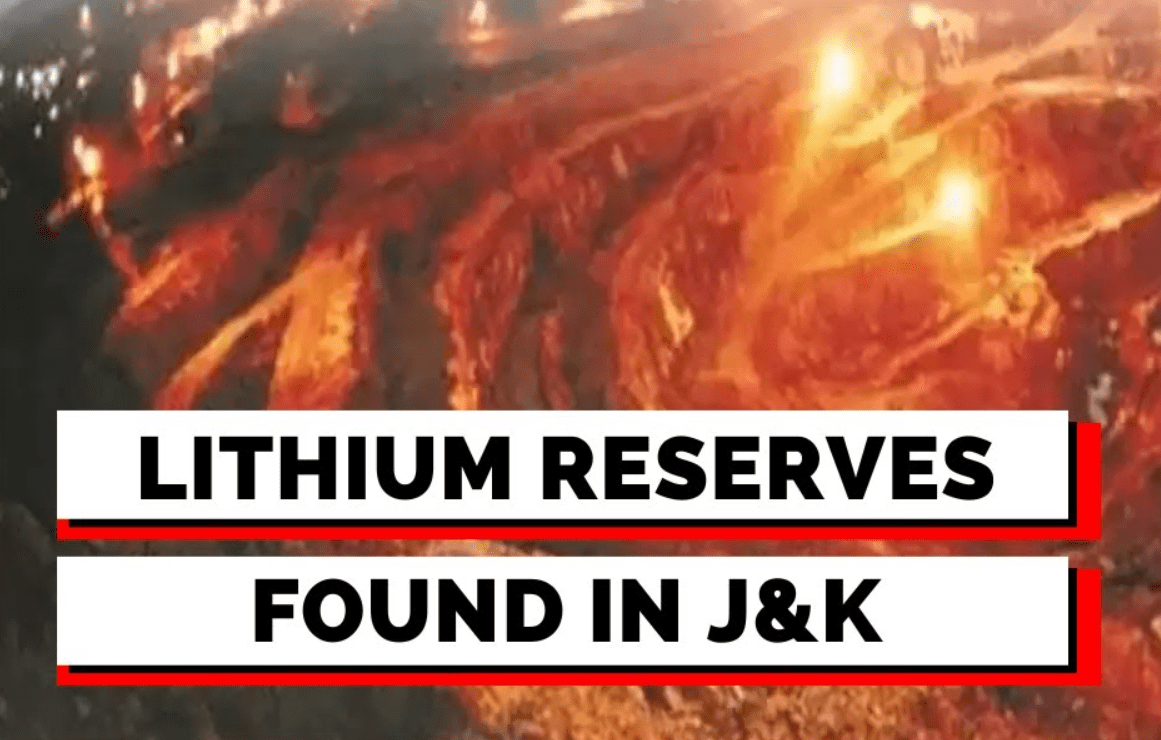Lithium Reserves in India Explained and History
Lithium Reserves in India Explained and History: In 1997, the Geological Survey of India published a report describing potential lithium reserves in Jammu and Kashmir, but unfortunately, no further action was taken. However, on February 9th, 2023, India’s Ministry of Mines announced a groundbreaking discovery massive lithium deposits have been found in the Salal-Haimana area of the Reasi District of Jammu & Kashmir, totaling 5.9 million tons.
With this discovery, India now ranks as the 5th largest lithium reserve holder in the world. Lithium is highly sought after due to its scarcity, hence why it is often referred to as “white gold.” Its importance lies in its applications, including its use as a key component in batteries for various electronic devices and electric vehicles (EVs).
The global EV industry is expected to surpass $800 billion by 2030, making the discovery of lithium in India a lucrative opportunity for Indian companies and the country as a whole. Currently, China dominates the production of EV batteries, with Contemporary Amperex Technology Ltd. (CATL) manufacturing 34% of global batteries, including Tesla’s EV batteries. This discovery raises the question of whether India can become an EV superpower.
What is Lithium?
In this article, we will discuss the entire process of lithium production, from what it is and how it’s used to manufacture lithium batteries. Lithium was discovered in 1817 by Swedish chemist Johan August Arfwedson and named after the Greek word ‘lithos,’ meaning stone. However, it took over a century for humans to recognize its full potential, and a geopolitical crisis in the 1970s sparked its importance due to the energy crisis the world was experiencing.
History of Lithium-ion Battery
During a time when Israel and some Arab countries were at war, the Arab nations decided to cut their oil supply to the US, as the US was supporting Israel. It was during this period that Stanley Whittingham, an English chemist working at ExxonMobil, began exploring the idea of a rechargeable battery that could reduce dependence on oil.
He used lithium, a light, and electrochemical material, in his prototypes. However, his early batteries short-circuited and caught fire. A few years later, an American scientist and a Japanese scientist created the first lithium-ion battery prototype, which comprises four key components: cathode, anode, separator, and electrolyte.
Working of Lithium-ion Batteries.
In a lithium-ion battery, electrons travel from the negative end (anode) to the positive end (cathode), where they are stored and produce energy that can power electronic devices such as laptops, phones, and even industrial machines and satellites. Lithium is mixed with graphite to make the anode, and either Cobalt or Nickel is mixed with lithium to make the cathode.
Sony commercialized this technology in 1991, using lithium-ion batteries in its electronic products. However, 90% of lithium-ion batteries are used in electric vehicles (EVs), which is where things take a dramatic turn.
Lithium-ion Batteries in EVs
Introducing the Tesla Model 3, but did you know that electric vehicles (EVs) have been around for over a century? In fact, they made up about 33% of all cars in the US in the 1900s, although they fell out of favor when gasoline-powered cars emerged. Early EVs had the disadvantage of using lead-acid batteries, which were slow to charge and had low mileage.
For 50 years, EVs were largely forgotten until the oil crisis in the 1970s prompted developed countries to seek alternatives to oil. This led to the development of more efficient batteries such as Nickel-Cadmium and Lithium-ion batteries, although these were initially expensive compared to traditional cars.
In the 21st century, Nickel-metal hydride batteries were introduced and used by Toyota in their hybrid cars, which can run on both petrol-diesel and electricity. Lithium-ion batteries were also in use but were initially considered unstable and inflammable. However, with continued research and development, EV car companies began to switch to lithium-ion batteries, which now power over 90% of EVs due to their high energy density, lightweight, and low self-discharge rate.
As the demand for EVs continues to rise globally, it’s estimated that the demand for lithium-ion batteries will increase sevenfold in the next eight years. The Indian government has set an ambitious target of having 30% of private vehicles on the roads be EVs by 2030, which has brought a wave of excitement amongst Indians about the discovery of the lithium reserve. However, the road to manufacturing lithium-ion batteries is not an easy one.
Who controls the supply chain of LiBs?
The supply chain of lithium-ion batteries is dominated by China, with the manufacturing process involving five key steps. The first step is mining, and while India has access to lithium reserves, other essential elements like cobalt, nickel, and magnesium will still need to be imported.
The second step is refining, where China has a significant stronghold with 58% of the world’s lithium processed there. The production of cell components such as cathodes, anodes, electrolytes, and separators is also dominated by China, controlling 78%, 66%, and 43% of the world’s cathode, anode, and separator production, respectively.
Even the most technologically advanced step, which involves the production of battery packs and Battery Management systems, is energy-intensive and presents a challenge for India. Therefore, while India has access to lithium, becoming self-sufficient in lithium-ion battery manufacturing will require significant investments in technology and infrastructure.
They are conducted in highly controlled conditions that must be devoid of moisture and impurities. Thus, advanced technology and a world-class factory are essential. Currently, only three companies manufacture 65% of the world’s batteries: Samsung from Korea, Panasonic from Japan, and China’s CATL. CATL, in particular, dominates global battery production with a 34% share.
This is precisely why India and the US are concerned, as China controls most aspects of the lithium-ion battery supply chain. If India or the US gets into a conflict with China, they risk being cut off from the supply of batteries. However, India has another crucial reason to manufacture batteries on its own. India’s tropical climate renders imported components unsuitable for its environment, where high temperatures are common.
As a result, the charging efficiency of batteries is impaired, and they are more prone to catch fire. For the batteries to withstand the heat of Rajasthan and the cold of Leh-Ladakh, India must manufacture components suitable for this diverse climate. Many Indian companies have been manufacturing lithium-ion batteries, but they don’t have control over the supply chain. These companies import essential components from outside the country and assemble them into batteries.
Current Status of LiB manufacturing in India
However, the Indian government has initiated an incentive scheme for companies to manufacture cells in India. Toshiba and Suzuki are already manufacturing cells in India under this scheme, and India has an advantage in low labor costs. Nevertheless, there are still numerous challenges to overcome.”
As I mentioned earlier, manufacturing cells for batteries requires state-of-the-art facilities, skilled workers, and advanced technology. While technology can be procured quickly, skilled workers are not produced overnight. Furthermore, India currently relies on other countries to import key components and materials, such as cathodes and electrolytes, which are not readily available in India.
While the recent discovery of lithium reserves in India is promising, it does not guarantee immediate economic gain. Therefore, it is essential to first understand the Geological Survey of India’s statement regarding the discovery. When geologists discover a mineral deposit, they categorize it based on their level of confidence.
The ‘inferred’ category, under the G3 stage, means that geologists have lower confidence in the discovery and have yet to proceed with the next two stages of exploration. Thus, India should not celebrate prematurely, as there is still a lot of work to do in terms of developing the necessary infrastructure and materials for battery production.
While the recent discovery of lithium reserves in Jammu and Kashmir is significant, it does not guarantee immediate economic gain. It is crucial to note that the emergence of new battery technologies could potentially replace lithium-ion batteries in the future. One such technology is the solid-state battery, which can store more energy in a given space and is safer than lithium-ion batteries. Solid-state batteries can be charged rapidly as the charged particles move faster.
Hydrogen-run vehicles are another alternative that could replace batteries with hydrogen fuel, utilizing the electric current produced by the reaction between hydrogen and oxygen. The recycling of lithium-ion batteries is also an alternative to consider. However, all three alternatives, solid-state batteries, hydrogen vehicles, and recycling lithium-ion batteries, are currently expensive due to a lack of research in the domain. If these alternatives become cheaper in the future, lithium-ion batteries may become obsolete. Another challenge is that lithium mining is not environment-friendly.
The process involves heating the ore at a high temperature, which is often achieved by burning fossil fuels, leading to a substantial amount of carbon dioxide being released into the atmosphere. The mining of one ton of lithium also requires a massive amount of water, which can exacerbate existing water scarcity issues in areas like the Reasi district of Jammu and Kashmir. Despite the discovery of lithium reserves, it is important to consider the environmental impact and explore alternative technologies that are both economically viable and sustainable.







